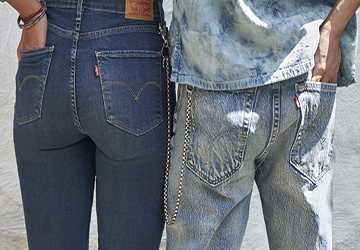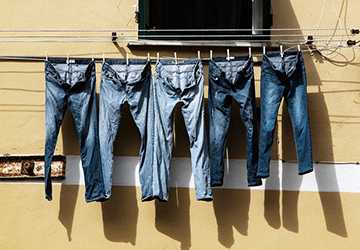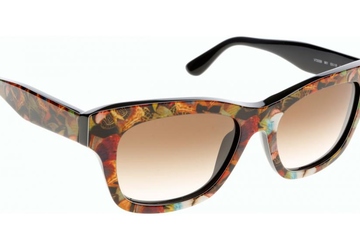Who Made the First Pair of Jeans
Tracing Back to the First Pair of Jeans
The first pair of jeans is a testament to a revolution in attire that has transcended generations, cultures, and fashion trends. This article explores the fascinating history of jeans, unravelling the story of how this ubiquitous garment came into existence.

Discovering the Inventor Behind the Iconic Garment
As we trace the history of jeans, it's clear that the journey is inextricably linked to Levi Strauss. This German-born entrepreneur became a central figure in creating the first pair of jeans as he ventured into San Francisco during the bustling California Gold Rush with the intent of trading supplies to the crowds of miners.
A Partnership Sewn into History
Strauss's collaboration with Jacob Davis catalyzed the birth of the first pair of jeans. Davis, a forward-thinking tailor, had the ingenious notion of using rivets to bolster the areas on pants that endured the most wear and tear. This innovation was geared toward crafting a more resilient garment for miners and laborer’s putting in strenuous hours during that era. Sensing the potential in this approach, Strauss and Davis merged their talents.
l Levi Strauss contributed to the rigid denim material.
l Jacob Davis introduced his pioneering method of reinforcement.
l Together, they secured a patent in 1873, marking the inception of the first pair of jeans. Initially, these garments were purely functional, crafted for strength over style.
The Metamorphosis of Jeans Over Decades
The narrative of the first pair of jeans is a chronicle of their metamorphosis from practical workwear to an essential item in contemporary fashion. As time passed, jeans became a versatile piece of clothing, continually adapted by different groups to symbolize their cultural and social ethos.
l Early 20th Century: Jeans symbolize the American West's rugged spirit.
l Mid-20th Century: The jeans wave hits the younger generation as a token of rebellion.
l 1960s & 1970s: The jeans craze spreads across various subcultures, becoming emblems of freedom and dissent.
l Late 20th Century Onward: Jeans solidify their status, becoming globally renowned and fashionably versatile.
The legacy of Levi Strauss and Jacob Davis is a resilient thread woven through the fabric of fashion's evolution, a testament to jeans' enduring appeal and adaptability. Their invention has stood the test of time and shaped how we view and wear casual attire. The first pair of jeans they introduced may be different in appearance from the designs we see today. Still, the durability and comfort they envisioned remain at the heart of this garment's lasting popularity.
The First Pair of Jeans: A Cultural Phenomenon
The narrative of the first pair of jeans is more than a chapter in the annals of fashion; it is a cultural phenomenon that speaks volumes about adaptability and resilience. These garments have a storied past that has seamlessly blended with various artistic movements, becoming an inseparable part of our social fabric.

Beyond the Gold Mines: Jeans as a Cultural Icon
After the first pair of jeans debuted, it was only a short time before they transcended their workwear roots. The robustness that made them ideal for the mines began to resonate with the broader public—each decade brought a new dawn for jeans, highlighting their unparalleled versatility.
l Post-War America: As soldiers returned home, they produced a fondness for the practicality of jeans.
l Rock 'n' Roll Era: Musicians and their fans donned jeans as a statement against the status quo, embedding them into the lexicon of cool.
l Rise of Designer Jeans: By the late 20th Century, jeans had ascended to high-fashion status, with designers elevating them to luxury items.
Jeans in the Global Landscape
The history of jeans reflects globalization's impact on fashion. What started with the first pair of jeans in the United States has now spread to every corner of the world. People across different continents have embraced jeans, each culture incorporating them into their unique style narratives.
l Asia: Here, jeans have been reinterpreted to align with local fashions, often incorporating traditional patterns and embellishments.
l European designers have left a significant mark on jeans, often leading the charge in trends and innovations.
l Africa and South America: These continents have witnessed a blend of jeans with vibrant local textiles, making bold fashion statements.
Technological Advancements and Sustainability
The journey from the first pair of jeans to today's pairs mirrors technological advancement. From the looms used to weave denim to the machines that stitch them together, technology has allowed for mass production while improving the quality and comfort.
However, with this mass production comes the challenge of sustainability—a pressing issue in the history of jeans. As environmental awareness rises, the fashion industry, including jeans manufacturers, is shifting towards more sustainable practices. This includes using organic cotton, reducing water usage, and recycling old jeans into new products.
Impact on Modern Fashion
The story of the first pair of jeans is not merely a chapter in the history of jeans but a continuous narrative that evolves with time. Designers and brands have taken the basic concept of jeans and turned them into a canvas for expression. The versatility of jeans is such that they have been adapted into countless styles, cuts, and colors.
Today, the first pair of jeans would look quite different from the myriad of designs we see. However, the core idea that Strauss and Davis brought to life remains the same—a sturdy pair of trousers that serves the wearer well.
Conclusion
The first pair of jeans were much more than pants; they were the progenitor of a garment that would permeate every level of society. The history of jeans is a multifaceted tale of innovation, culture, and identity, and their story is far from over. As fashion continues to evolve, the first pair of jeans remains a cornerstone, reminding us that from sturdy beginnings come timeless legends.





